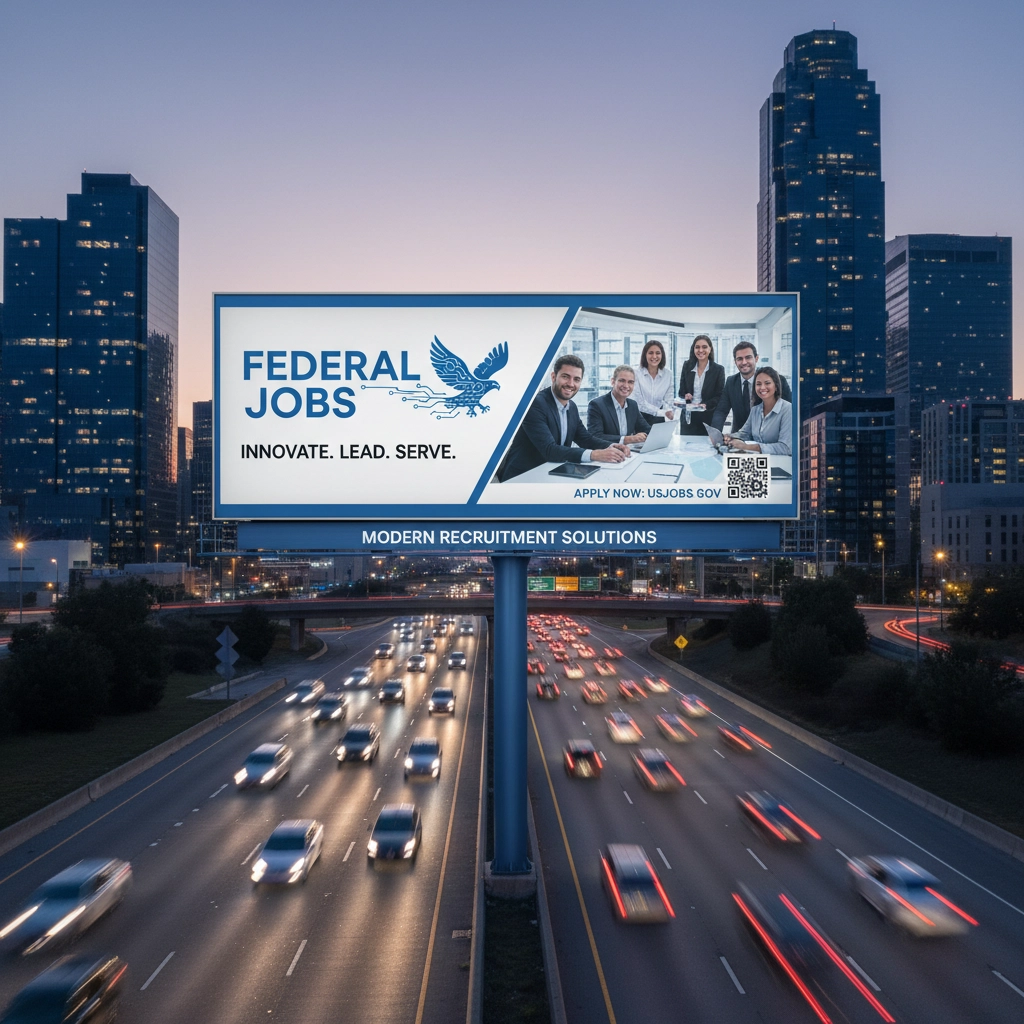Federal job postings continue to reflect an antiquated approach to recruitment that mirrors the regulatory stagnation observed in highway advertising standards, creating a systematic barrier to attracting qualified candidates in an increasingly competitive employment landscape. The parallel between these two bureaucratic systems reveals fundamental issues with rigid regulatory frameworks that prioritize compliance over effectiveness, ultimately undermining their stated objectives of efficient governance and talent acquisition.
The Systematic Failure of Federal Recruitment Technology
The federal government's hiring infrastructure demonstrates a comprehensive failure to adapt to modern recruitment methodologies, resulting in technological systems that lag decades behind private sector standards. Federal agencies continue to rely on outdated applicant tracking systems, bureaucratic language protocols, and rigid formatting requirements that were established during an era when digital recruitment was in its infancy. This technological stagnation manifests most prominently in job postings that read like administrative documents rather than competitive opportunities designed to attract top-tier talent.

The underlying technology supporting federal hiring processes has fundamentally failed to keep pace with commercial innovations in recruitment marketing, automated screening systems, and candidate relationship management platforms. While private sector organizations have embraced sophisticated recruitment technologies including artificial intelligence-driven candidate matching, automated scheduling systems, and dynamic content personalization, federal agencies remain constrained by systems that were considered cutting-edge in the 1990s but now represent significant obstacles to efficient talent acquisition.
Federal hiring maintains antiquated posting requirements while failing to achieve the actual goal of attracting top talent efficiently, creating a systematic disconnect between process and purpose.
The Highway Advertising Regulatory Parallel
The Highway Beautification Act of 1965 established a regulatory framework for outdoor advertising that created permanent constraints on billboard standards, including specifications for size, spacing, lighting, and placement that effectively froze the industry at mid-1960s technological and aesthetic standards. This regulatory ossification demonstrates how well-intentioned bureaucratic controls can create systemic barriers to innovation and adaptation, resulting in standards that become increasingly divorced from contemporary needs and capabilities.
The enforcement mechanisms established under the Highway Beautification Act reveal additional parallels to federal hiring challenges, as the Federal Highway Administration has demonstrated inconsistent enforcement of its own standards while maintaining the underlying regulatory framework that prevents modernization. This pattern of selective enforcement combined with rigid adherence to outdated standards creates a regulatory environment that neither achieves its intended objectives nor allows for meaningful adaptation to changing circumstances.

Federal job posting requirements exhibit similar characteristics, maintaining bureaucratic language standards and formatting protocols that were designed for different technological and cultural contexts while failing to achieve the fundamental goal of attracting qualified candidates efficiently. The result is a system that prioritizes procedural compliance over recruitment effectiveness, creating barriers to both candidate engagement and organizational efficiency.
Transportation Marketing as a Modernization Model
Contemporary transportation advertising demonstrates the potential for regulatory frameworks to adapt to modern communication technologies and audience expectations while maintaining necessary standards for public safety and aesthetic considerations. Modern highway advertising campaigns utilize dynamic content management systems, real-time audience analytics, and integrated digital platforms that allow for sophisticated targeting and measurement capabilities that were inconceivable under the original 1965 regulatory framework.
The transportation advertising industry has successfully navigated the transition from static, standardized messaging to dynamic, data-driven campaigns that maintain regulatory compliance while maximizing audience engagement and measurable outcomes.
Transportation marketing platforms now incorporate software-as-a-service solutions that enable real-time campaign optimization, audience segmentation, and performance analytics that provide measurable returns on advertising investment. These technological capabilities demonstrate how regulatory frameworks can evolve to accommodate innovation while maintaining necessary oversight and standards compliance.
The Scale of Federal Hiring Challenges
Federal job applications experienced a surge of over fifty percent at certain agencies during early 2025, creating unprecedented competition for government positions and highlighting the critical importance of effective recruitment marketing strategies. This dramatic increase in applicant volume makes the modernization of federal job posting strategies even more essential, as outdated posting formats and bureaucratic language will fail to differentiate attractive opportunities from routine administrative positions within an expanded candidate pool.

The established federal hiring timeline of eighty-one days for completing recruitment processes, originally set as a best practice standard in 2012, remains largely unachieved across most agencies nearly thirteen years later. This persistent failure to meet established performance metrics indicates systemic issues with the underlying recruitment infrastructure rather than isolated problems with specific agencies or personnel.
Technological Solutions and Implementation Strategies
Federal agencies require immediate adoption of commercially available, FedRAMP-certified hiring technologies that have demonstrated success in large enterprise environments, rather than continuing to defend outdated systems that create barriers to efficient recruitment. Early-adopter agencies have successfully implemented modern hiring platforms that significantly accelerate recruitment timelines while improving candidate experience and reducing administrative burden on hiring managers.
The integration of transportation marketing principles into federal recruitment strategies offers specific advantages including dynamic content management, real-time performance analytics, and automated candidate engagement systems that maintain compliance with federal hiring regulations while dramatically improving recruitment efficiency. These integrated approaches demonstrate how modern advertising technologies can be adapted to meet the specific requirements of federal hiring while delivering measurable improvements in candidate quality and hiring timeline performance.
Modern transportation advertising technologies provide proven frameworks for dynamic content delivery, audience targeting, and performance measurement that can be directly applied to federal recruitment challenges.
Implementation Framework for Federal Agencies
Federal agencies can implement modernized recruitment marketing strategies by adopting proven transportation advertising technologies that provide dynamic content management, automated audience targeting, and comprehensive performance analytics while maintaining full compliance with existing federal hiring regulations. These implementation strategies require agency leaders to prioritize recruitment effectiveness over bureaucratic tradition, embracing technological solutions that have demonstrated success in both private sector and early-adopter federal environments.

The successful integration of modern recruitment marketing technologies requires comprehensive training programs for hiring managers, updated procurement processes for technology acquisition, and revised performance metrics that prioritize candidate engagement and hiring timeline efficiency over traditional process compliance measures. Federal agencies that have successfully implemented these modernization strategies report significant improvements in candidate quality, reduced hiring timelines, and increased acceptance rates for job offers.
Regulatory Reform and Future Directions
The systematic modernization of federal recruitment practices requires regulatory reforms that provide flexibility for agencies to adopt proven commercial technologies while maintaining necessary oversight and compliance standards. These reforms should prioritize measurable outcomes including candidate engagement rates, hiring timeline efficiency, and long-term employee retention rather than focusing exclusively on process compliance metrics that may not correlate with recruitment effectiveness.
Federal hiring modernization requires agency leaders to break established patterns and rapidly adopt modern hiring technologies rather than defending outdated systems that create barriers to organizational effectiveness.
Transportation marketing success stories provide concrete examples of how regulatory frameworks can evolve to accommodate technological innovation while maintaining necessary standards and oversight mechanisms. Federal agencies can learn from these examples by implementing flexible procurement processes, performance-based evaluation criteria, and continuous improvement methodologies that enable rapid adaptation to changing technological and market conditions.
Share this post:
SEO Tags: federal hiring, transportation advertising, government recruitment, highway advertising, recruitment technology, federal job postings, transportation marketing, government modernization
Hashtags: #FederalHiring #TransportationAdvertising #GovernmentRecruitment #HiringTechnology #FederalJobs #TransportationMarketing #AdvertisingTechnology #GovernmentModernization #RecruitmentStrategy #DigitalAdvertising
Ready to modernize your organization's recruitment strategy with proven transportation advertising technologies? Contact Teltrans today to discover how our comprehensive advertising and marketing solutions can transform your hiring outcomes while maintaining full regulatory compliance.

